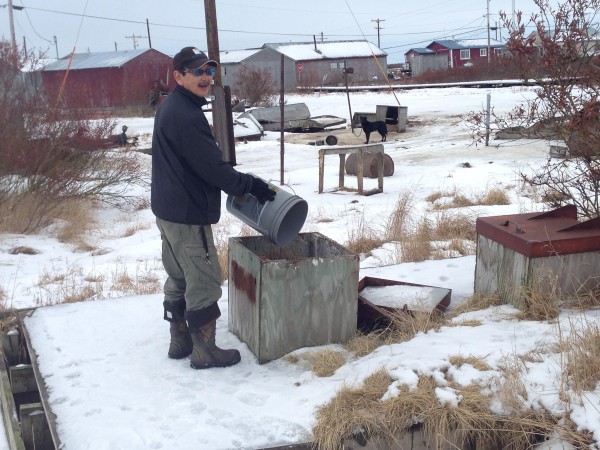
Joaqlin Estus KNBA
You don’t have to go to a foreign country to find Third World conditions. You can find more than six percent of Alaskans living in those conditions – without modern running water or sewer systems. The so-called “honey bucket” situation has frequently been deplored and millions of federal and state dollars have been devoted to dealing with it. But the reality remains that people in 3,300 households in the state live without running water and flush toilets and have much higher rates of hospitalization for respiratory and skin infections. Are there solutions? Maybe? Are we getting closer to those solutions? Maybe not. Today we begin a five-part series entitled “Kick the Bucket,” in which we’ll get a closer look at the water and sewer situation in rural Alaska. In part one, we look at the public health implication of inadequate water supplies.
If you’re one of Kwethluk’s 750 residents, you’re 400 miles from the road system that serves Anchorage and Fairbanks, 120 miles from the Bering Sea, and near a branch of the Kuskokwim River. In the winter, this is how you get water for your household.
“You have to chip the ice away. You have to chip and chip, especially when it was really cold and the ice was thick,” said Claudia Hansen.
Until Hansen’s home gets hooked up to a new piped water and sewer system, her son continues to haul ice from the Kwethluk River. Once it melts and the silt settles, it’s ready to use — and drink.
Fifty miles up the Kuskokwim River, in Tuntutuliak, Lucy Lupie says fetching water is a young man’s job.
“Since my husband is getting older, it is harder for him to get ice,” said Lupie.
Alaskans without plumbing also collect rainwater, or buy water at a central watering point, often carrying home 5-gallon jugs weighing about 40 pounds each. After all that effort, people use water sparingly – as little as two gallons per person per day. Fifteen gallons a day is considered necessary to stay clean, and the average American uses 80 to 100 gallons of water a day. One way villagers conserve water is by sharing a basin of soapy water for hand washing.
Especially for little ones, this can foster respiratory infections, as Kivalina Community Health Aide Isabell Booth explains.
“A lot of respiratory illness,” said Booth. “We had a lot of pneumonia and bronchiolitis in like two and under.”
CDC studies show Alaskans without plumbing get invasive pneumococcal infections up to eleven times more often that other Alaskans. In Southwest Alaska, where 40% of the homes lack plumbing, one in four infants is hospitalized for severe respiratory infection.
In Northwest Alaska, Kivalina gets its water from a river, and sometimes can’t get enough to last all year. Booth says she sees the effects when the water tanks are closed.
“Every time our water gets low when they shut down, I start to see abscess, skin problems like abscess start coming around and go on for probably a month or two to where they have to be treated with antibiotic,” said Booth.
When people can’t use outhouses due to permafrost or boggy ground, for instance, they use a bucket fitted with a toilet seat, a “honey bucket,” which gets emptied every day — or so. In Tuntutuliak, Adolf Lupie carries his family honey-bucket down a boardwalk leading to an underground bunker. He laughs as he advises caution.
“Make sure it’s not slippery around here or we’ll slip and the honey bucket will be over us.”
After emptying the bucket, and back indoors, Lupie says it’s worse when it’s warmer.
“When the spring time comes, it’s really gross and smelly,” he said.
People are frustrated but most say they wouldn’t move just to have plumbing. Many villagers have strong ties, like Lucy Lupie who says she doesn’t know who she’d socialize with in larger communities.
“It’s where our relatives are,” said Lupie. “Like if I was in the city, where would I turn to for help or even to socialize?”
And, many rural communities have thrived for centuries because they’re ideally situated for food gathering. Stanley Hawley, of Kivalina, says he’s driven by the imperative, and rewards, of supporting his family with food from nature.
“Once we get exposed to that livelihood, that way of living, it gets ingrained in our spirit, and in our soul, and in our psyche,” said Hawley.
Health experts say near-universal piped water and sewer is one of, if not the most important American public health achievement of the 20th century. It helped cut U.S. mortality rates by 40%, and raise life expectancy from 47 to 63 years. Later we’ll hear about some of the reasons so many Alaskans still live without plumbing.
Joaqlin Estus is a reporter at KNBA in Anchorage.




